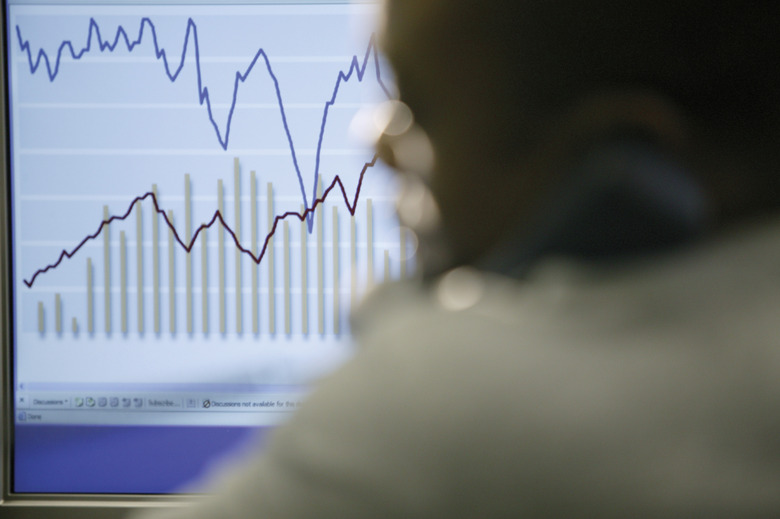The purpose of a graph is to show the relationship between something measured and something that is assumed to change its amount. For example, a line graph might show how much a plant grows as time passes. Or, a bar graph might show how ice cream sales differ over the four seasons. You can calculate the percent increase in either type of graph. Calculating percentage increase allows you to learn how much the variable being measured has grown compared to its initial amount.
The Y-Axis of a Graph
The y-axis of a graph is the vertical axis. This is the axis where you plot the values of what you’ve measured. On a line graph showing plant growth over time, you might label the y-axis plant height, and the scale of this axis would determine the vertical position of your data points. On a bar graph showing seasonal ice cream sales, you might label the y-axis ice cream sales, and the scale of the axis would determine the vertical position of your data points. Since the y-axis shows how the amount of what you’ve measured has changed, you’ll calculate percentage increase from the values shown on the y-axis.
The X-Axis of a Graph
The x-axis is the horizontal axis of a graph. This is the axis where you plot the values of your period of measurement, or the categories over which you expect your measured value to change. On a line graph showing plant growth over time, you might label the x-axis time, and you would show the duration of time you allowed the plant to grow. On a bar graph showing seasonal ice cream sales, you might label the x-axis with the four seasons to indicate the placement of the four bars on the graph. The x-axis provides the reference points of comparison that you will use to calculate percentage increase.
Line Graph Example
Consider a line graph that shows the growth of a plant over a 10-day period. Assume that on Day 1, the position of the data point on the y-axis indicates that the plant was 10 inches tall; on Day 10, the position of the data point on the y-axis indicates that the plant was 15 inches tall.
How do you calculate the percent increase from Day 1 to Day 10?
You subtract the final data point of 10 inches from the original data point of 15 inches, like this:
15 inches – 10 inches = 5 inches
The answer shows how many inches the plant grew. Now, divide the answer of 5 inches by the original data point of 10 inches and convert that answer of .5 to a percent by multiplying by 100, like this:
(5 in / 10 in) = .5 x 100 = 50
You can see that the plant grew by 50 percent.
Bar Graph Example
Consider a bar graph that shows a dessert shop’s total ice cream sales during the four seasons of the year. In winter, the height of the bar on the y-axis indicates total ice cream sales of $2,000. In summer, the height of the bar on the y-axis indicates total ice cream sales of $3,800.
How do you calculate the percent increase from winter to summer?
The formula is the same as with the example of the growing plant. You subtract the new data point of $2,000 from the original data point of $3,800, like this:
$3,800 – $2,000 = $1,800
The answer shows you by how many dollars your ice cream sales increased from winter to summer.
Now, divide your answer of $1,800 by the original data point of $2,000 and convert that answer of .9 to a percent by multiplying by 100, like this:
$1,800 / $2,000 = .9 x 100 = 90 percent
You can see that the dessert shop experienced a 90 percent increase in ice cream sales during the summer months, compared to the winter months.

